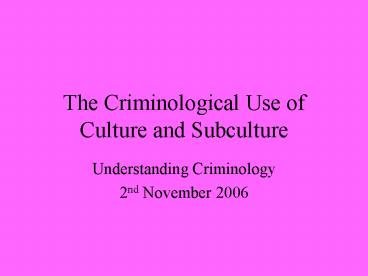The Criminological Use of Culture and Subculture - PowerPoint PPT Presentation
Title:
The Criminological Use of Culture and Subculture
Description:
The Criminological Use of Culture and Subculture Understanding Criminology 2nd November 2006 Lecture Outline Subculture: Definitions and Typology Gangs and the ... – PowerPoint PPT presentation
Number of Views:199
Avg rating:3.0/5.0
Title: The Criminological Use of Culture and Subculture
1
The Criminological Use of Culture and Subculture
- Understanding Criminology
- 2nd November 2006
2
Lecture Outline
- Subculture Definitions and Typology
- Gangs and the variety of adaptations to strain
- Social Class and Subculture
- Drift Theory
3
Culture and Subculture
- Adaptations of Strain theory, with an awareness
of the diversity of deviant forms - Initial focus on gangs and youth delinquency
4
Subculture Definitions
- A relatively small grouping that develops
distinctive norms, values and beliefs.
Subcultures provide members with a range of
personal resources (e.g. status, capital,
excitement) that have often been denied by
mainstream society / culture - Subcultural Theory aim to identify the cause and
expressive nature of subcultures
5
Typology
- Reactive / Oppositional Subcultures
- The subcultural form is a direct reaction against
mainstream culture - Most directly influenced by strain theory
- Independent Subcultures
- Subcultures develop their own values and norms
of behaviour independently of mainstream culture
6
William Whyte Street Corner Society
- Easier for a slum resident to achieve monetary
success in a racket, than by conventional means - Role models college boys v. corner boys
- Gang activities highly organised
- Pioneering participant observation based study
- KEY expressive nature of subcultures
7
Sutherlands Differential Association Theory
- Delinquent practices are culturally transmitted
from one individual to another - Cultural conflict if definitions favourable to
law violation outweigh those unfavourable, crime
will occur - Applied largely to white-collar crime, but has
subsequently been applied to other crime - KEY Cultural Transmission
8
National Strain / Inequality / Limited
Opportunities
Community Legitimate and Illegitimate
Opportunities
9
Albert Cohen Delinquent BoysThe culture of
the gang
- Subculture evolved in response to strain, and a
rejection of middle-class values - Education paramount
- Make children aware of social status
- Key to the constraint of opportunities
- Goal status, not necessarily monetary success
- An attempt to understand non-economic deviance
- Gangs were a particular form of subcultural
adaptation, characterised by-
10
Richard Cloward and Lloyd Ohlin
- Focussed on the range that adaptations to strain
could take, incorporating differential
association - Criminal Gangs
- Conflict Gangs
- Retreatist Gangs
- Returned to Mertons focus on monetary success
11
Evaluation of Strain Influenced Subcultural
Theories
- Fits with
- Over-representation of working class, urban
offenders in gang activity - A dominant / superior middle class culture
- Possibly fits with
- Gang activity being predominantly male girls and
young women have alternative sources of status? - Doesnt fit with
- Widespread, but petty offending
- British experience
12
David Downes a British Perspective
- In Britain, social class is central to
understanding subcultural adaptation - Working class youth had a realistically low
level of aspiration / fatalism - Delinquency as a fact of life, but not a way
of life
13
Downes and Subculture in Britain
- Key cause of delinquency boredom and the
importance of leisure - little opportunity for excitement (akin to
strain) - leisure became the location for excitement and
expression of - - toughness, daring, panache
- Links between leisure and delinquency
- proceeds of crime funding leisure
- delinquency is itself exciting
- delinquency is a by-product of certain forms of
excitement
14
Marxist analysis of sub-culture / counter-culture
- Phil Cohen
- Economic Decline -gt
- family tensions
- fragmented community
- economic insecurity
- Mods socially mobile white-collar worker
- Skinheads emphasising masculinity of hard manual
labour
15
David Matza Drift and Neutralization
- Sees subcultural theories are over-predictive
- Drift a limbo between convention and crime
preceding delinquency - Techniques of neutralization demonstrate
continued commitment to mainstream cultural
values - Delinquency represents the exaggeration of
subterranean, but not deviant values - the pursuit of excitement
- the disdain for routine work
- toughness and masculinity
16
What is a Cultural of Deviance?
- Pockets of specific activities providing meaning
and resources to the member - E.g. The Gang
- A widespread loose affinity between relatively
informal groupings - E.g. Anti-globalisation environmental groups
- A reflection of temporary adolescent rejection of
parental / mainstream values functional? - A vital mechanism that acts to support and
- reproduce mainstream culture
17
Summary
- Most cultural theories would expect more
criminality than actually seen - Matza and Drift theory would not predict much
career criminality - Cultural Relativism a danger that criminality is
romanticized the expressive qualitative nature
of deviance is addressed rarely the same focus
on mainstream culture or victimisation































